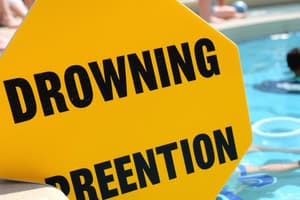Podcast
Questions and Answers
Which triage category is designated for patients who require immediate medical attention?
Which triage category is designated for patients who require immediate medical attention?
- Yellow
- Red (correct)
- Black
- Green
What is a known risk factor for Sudden Infant Death Syndrome (SIDS)?
What is a known risk factor for Sudden Infant Death Syndrome (SIDS)?
- High birth weight
- Frequent pediatric check-ups
- Maternal smoking (correct)
- Breastfeeding
What common condition can mimic the symptoms of SIDS?
What common condition can mimic the symptoms of SIDS?
- Hypertension
- Nutritional deficiency
- Airway obstructions (correct)
- Severe dehydration
Which of the following is a critical first step in managing pediatric emergencies?
Which of the following is a critical first step in managing pediatric emergencies?
What is a vital role of first responders when a child’s death occurs?
What is a vital role of first responders when a child’s death occurs?
What does BRUE stand for in pediatric medicine?
What does BRUE stand for in pediatric medicine?
During a pediatric assessment, why is it important to communicate with the family?
During a pediatric assessment, why is it important to communicate with the family?
In the context of Critical Incident Stress Management, what should responders be aware of?
In the context of Critical Incident Stress Management, what should responders be aware of?
What primary factor contributes to drowning incidents among adolescents?
What primary factor contributes to drowning incidents among adolescents?
What is the correct first step before attempting a water rescue?
What is the correct first step before attempting a water rescue?
What is a common sign of drowning-related injury?
What is a common sign of drowning-related injury?
Which type of injury poses a significant risk for children in vehicle collisions?
Which type of injury poses a significant risk for children in vehicle collisions?
What contributes to the severity of burns in children?
What contributes to the severity of burns in children?
What action should be taken when suspected child abuse is observed?
What action should be taken when suspected child abuse is observed?
What is a characteristic of the Jump START triage system?
What is a characteristic of the Jump START triage system?
What is a key reason children are more prone to accidents compared to adults?
What is a key reason children are more prone to accidents compared to adults?
Flashcards are hidden until you start studying
Study Notes
Drowning and Unintentional Deaths in Children
- Drowning is the leading cause of unintentional deaths in children aged 1-4 in the US.
- Common drowning scenarios include swimming pools, lakes, bathtubs, and buckets of water.
- Lack of safety measures and parental supervision, along with alcohol consumption, contribute to drowning incidents, particularly among adolescents.
- Signs of drowning-related injury include coughing, choking, airway obstruction, and respiratory issues.
- Hypothermia can occur in cases of submersion in icy water, presenting with a slow or absent pulse and cyanotic skin.
Water Rescue Protocol
- Ensure personal safety before attempting water rescues; untrained individuals should not enter the water.
- Assess and manage airway, breathing, and circulation (ABCs).
- Administer 100% oxygen and assist with ventilations as necessary.
- Prepare for suctioning due to potential water in lungs/stomach.
- Apply a cervical collar for suspected spinal injuries and utilize backboards for transport.
Pediatric Trauma and Injuries
- Trauma is the leading cause of death in children; common causes include suffocation, drowning, falls, and abuse.
- Motor vehicle accidents pose significant risks for children aged 5 and older.
- Children have underdeveloped judgment, making them more prone to accidents.
- Head and neck injuries should be carefully assessed due to the disproportionate size of a child's head relative to their body.
Vehicle Collision Injuries
- The area of injury in children differs from adults due to their body structure and height.
- Common injuries include high-energy traumas to the head, spine, abdomen, and pelvis.
- Children’s softer skulls can bleed easily, leading to significant blood loss.
Burns and Neglect
- Burns are more serious in children due to greater surface area and susceptibility to shock.
- Primary sources of burns include hot substances and caustic agents.
- Neglect results in developmental delays and lack of essential life necessities.
Child Abuse Awareness
- Child abuse encompasses physical, sexual, emotional abuse, and neglect.
- Approximately 700,000 cases of child abuse are reported annually in the US.
- Signs to watch for include conflicting stories from caregivers, multiple injuries, and delayed medical care.
- Providers must report suspected abuse without needing conclusive evidence.
Jump START Triage System
- Designed specifically for pediatric patients under 8 years old or weighing less than 100 lbs.
- Four triage categories: Green (minor), Yellow (delayed), Red (immediate), Black (deceased).
- A child’s ability to walk can impact their triage classification in mass casualty situations.
Sudden Infant Death Syndrome (SIDS)
- SIDS is the sudden, unexplained death of an infant after autopsy.
- Risk factors include maternal smoking, low birth weight, and unsafe sleeping practices.
- SIDS deaths often occur in the morning when caregivers check on the infant.
Critical Incident Stress Management
- Provide support to families experiencing a child's death.
- Be aware of potential post-traumatic stress symptoms in rescuers, including nightmares and anxiety.
- Access resources for mental health support within organizations post-incident.
Assessment Protocols
- Carefully assess the scene during a pediatric emergency, noting environmental and health factors.
- Communication and support with families are vital components of managing pediatric emergencies.### Sudden Infant Death Syndrome (SIDS) and Related Conditions
- Common causes of conditions mimicking SIDS include accidental suffocation, strangulation, overwhelming infection, and airway obstructions.
- Risk factors for SIDS prevention involve avoiding co-sleeping and removing loose blankets/items from the crib.
- Other potential causes include meningitis, accidental/intentional poisoning, hypoglycemia, and congenital metabolic defects.
Assessment and Management Protocols
- Initiate assessment with ABCs (Airway, Breathing, Circulation).
- Signs of postmortem changes may include rigor mortis (body stiffening) and dependent lividity (blood pooling).
- If signs of rigor mortis or dependent lividity are present, communication with medical control is necessary.
Decision-Making in Resuscitation Efforts
- Starting CPR can be challenged by family expectations and visible postmortem signs; initiate CPR if no signs of death are present.
- Document any prior interventions performed by family or first responders before arrival.
- Communication with the family is crucial; always introduce yourself and gather the child’s details sensitively.
Grieving Family Support
- Inform families immediately when decisions about resuscitation efforts are made.
- Avoid speculation about the child’s death; leave inquiries to law enforcement.
- Allow families to express grief and provide support while respecting their emotional needs.
Brief Resolved Unexplained Events (BRUE)
- BRUE refers to episodes where infants appear unresponsive and cyanotic but may return to normal with stimulation or time.
- Characteristic signs include changes in muscle tone or choking/gagging.
- Despite apparent recovery, thorough assessments and immediate transport to the emergency department are essential.
- Caregivers should be allowed to accompany the child in the ambulance; clarify that causal determinations will be made by medical professionals post-event.
Drowning and Unintentional Deaths in Children
- Drowning is the primary cause of unintentional fatalities in children aged 1-4 in the US.
- Typical drowning scenarios occur in swimming pools, lakes, bathtubs, and even buckets.
- Contributing factors to drowning include inadequate safety measures, lack of supervision, and alcohol use, especially in adolescents.
- Indicators of drowning-related injuries encompass coughing, choking, and respiratory distress.
- Cold water immersion can lead to hypothermia, with symptoms like a slow pulse and bluish skin.
Water Rescue Protocol
- Personal safety is paramount before initiating a water rescue; untrained individuals should not attempt to enter the water.
- Assess the airway, breathing, and circulation (ABCs) of the victim.
- Provide 100% oxygen and assist with ventilation if needed.
- Prepare for suctioning, as water may be present in the lungs or stomach.
- Use a cervical collar for suspected spinal injuries and backboards for patient transport.
Pediatric Trauma and Injuries
- Childhood trauma is the leading cause of death, commonly resulting from suffocation, drowning, and falls.
- Motor vehicle accidents significantly endanger children aged 5 and older.
- Children have limited judgment abilities, increasing their accident risk.
- Head and neck injuries require careful evaluation due to a child's larger head proportion.
Vehicle Collision Injuries
- Injury patterns in children differ from adults due to body structure.
- Typical injuries sustained include high-energy trauma to the head, spine, and abdomen.
- Children’s softer skull composition can lead to substantial blood loss from minor injuries.
Burns and Neglect
- Burns in children are critical due to larger body surface area and higher shock susceptibility.
- Main burn sources include hot substances and corrosive agents.
- Neglect can lead to developmental delays and deprivation of basic life necessities.
Child Abuse Awareness
- Child abuse includes physical, sexual, emotional abuse, and neglect.
- Approximately 700,000 child abuse cases are reported each year in the US.
- Warning signs encompass inconsistent caregiver accounts, multiple injuries, and delayed treatment.
- Providers are obligated to report suspected abuse without needing definitive evidence.
Jump START Triage System
- Developed for pediatric patients under 8 years old or under 100 lbs.
- Triage categories include Green (minor), Yellow (delayed), Red (immediate), and Black (deceased).
- A child's ability to walk influences their triage level in mass casualty scenarios.
Sudden Infant Death Syndrome (SIDS)
- SIDS is characterized by the sudden, unexplained death of an infant post-autopsy.
- Risk factors involve maternal smoking, low birth weight, and hazardous sleeping practices.
- Most SIDS incidents occur in the morning when caregivers routinely check on infants.
Critical Incident Stress Management
- Support families coping with a child's death to alleviate trauma.
- Be alert to potential post-traumatic stress symptoms in rescuers indicating anxiety or nightmares.
- Mental health resources should be accessible within organizations for post-incident support.
Assessment Protocols
- Conduct thorough scene assessments during pediatric emergencies, considering environmental and health variables.
- Effective communication and support for families are essential during pediatric emergency management.
Sudden Infant Death Syndrome (SIDS) and Related Conditions
- Conditions that may mimic SIDS include accidental suffocation, strangulation, and infections.
- SIDS prevention strategies involve avoiding co-sleeping and eliminating loose items from cribs.
- Other cause considerations include meningitis, poisonings, hypoglycemia, and congenital metabolic disorders.
Assessment and Management Protocols
- Begin assessment by evaluating airway, breathing, and circulation (ABCs).
- Recognize signs of postmortem changes, such as rigor mortis and dependent lividity.
- If signs of rigor mortis or lividity are noted, communication with medical control is crucial.
Decision-Making in Resuscitation Efforts
- Initiate CPR if no definitive signs of death are present, despite family expectations.
- Document any actions taken by family or first responders before the arrival of emergency services.
- Engage with the family respectfully, introduce yourself, and gather the child’s information sensitively.
Grieving Family Support
- Communicate decisions regarding resuscitation efforts to families promptly.
- Avoid making assumptions about the cause of death; let law enforcement handle inquiries.
- Provide emotional support while allowing families to grieve openly.
Brief Resolved Unexplained Events (BRUE)
- BRUE describes episodes of infants appearing unresponsive but may normalize with stimulation.
- Characteristic signs include muscle tone changes and choking or gagging.
- Despite recovery, thorough assessments and immediate transport to emergency care are critical.
- The option for caregivers to accompany the child in the ambulance should be clarified, noting that causal determinations will be made by medical professionals later.
Studying That Suits You
Use AI to generate personalized quizzes and flashcards to suit your learning preferences.




